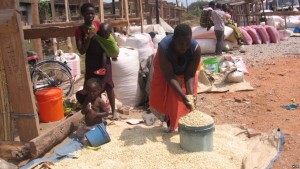
Maize is the most important staple food in Malawi, contributing about 66 percent of calories to typical household diets. Most non-seed maize is produced by smallholder farmers while large farms mainly produce seed maize. Thus, the nation’s food security and poverty reduction is dependent on the maize market. However, maize retail prices are high whereas producer prices remain low. In trying to understand this food price dilemma, a recent IFPRI study by Dennis Ochieng and Rosemary Botha, investigates the structure, conduct, and performance of Malawi’s maize market. The study aims to understand how the interactions within the maize marketing environment influence the availability, accessibility, and affordability of maize, and also to suggest ways to improve the functioning of the county’s maize marketing system.
The study employs a mixed methods approach, with semi-structured interviews of 555 traders of various types, in addition to focus group discussions with maize farmers in 28 locations. The fieldwork was done in 7 districts and 14 Extension Planning Areas (EPAs) from Mulanje in the South, to Chitipa in the North. The study examines the channels through which maize flow from producers to consumers, retail maize price volatility, spatial (intra and inter-regional) market integration and speed of price transmission across markets.
The study's preliminary research findings were presented during a research seminar held on 9th October 2018 at the IFPRI Malawi office. The findings show that the maize market environment in Malawi is pyramidical in nature; with most traders at the lower tiers and fewer large private traders at the higher tiers. Consequently, competition is more intense at the lower than higher tiers of the maize value chain. Small traders perceive that large private traders set prices, depressing maize prices during main marketing season and then inflate the prices at the peak of the lean season. Farmers perceive that they are price-takers, with limited market opportunities beyond farm gate. Both farmers and small traders are affected by discretionary policies, such as the maize export bans, which create uncertainties and hence, discourage maize production and trading. They also believe that the Agriculture Development and Marketing Corporation (ADMARC) is serving more the interests of large private traders and influential business owners than of smallholder farmers and small traders.
In terms of the performance of the maize market, Ochieng and Botha found that maize prices have been highly volatile over the past three years. As expected, prices are low at the peak of the harvest season and high at the peak of the lean season. However, the prices in the different markets do not follow the same patterns, which indicates poor spatial market integration between and within regional markets.
To ensure a well-functioning maize market, the study argued that there is need to have a policy mix that; (i) fosters productivity growth among small farmers; (ii) encourages large farms to expand production of non-seed maize; and, (iii) broadens the scope and depth of private sector involvement in maize marketing. These recommendations led to a long discussion among participants on: viability of smallholder commercialization in situations of volatile prices and unpredictable trade policy that disincentivizes commercial maize production; ways to increase private sector investment in maize storage; and, ways to promote public-private sector coordination of maize marketing in Malawi.
